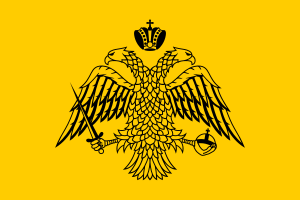Chính thống giáo Hy Lạp
Chính thống giáo Hy Lạp là thuật từ đề cập tới một số giáo hội[5][6][7] trong khối hiệp thông Chính thống giáo Đông phương mà phụng vụ được cử hành bằng tiếng Hy Lạp Koine,[8] ngôn ngữ gốc của Kinh Thánh Tân Ước,[9][10] chia sẻ chung lịch sử, truyền thống và thần học bắt nguồn từ các Giáo Phụ tiên khởi và văn hóa của Đế quốc Byzantium. Kitô giáo Chính thống Hy Lạp cũng nhấn mạnh đặc biệt tới truyền thống đan tu và khổ tu, có nguồn gốc từ thời sơ khởi của Kitô giáo tại Cận Đông và Tiểu Á.
| Chính thống giáo Hy Lạp | |
|---|---|
 | |
| Người thành lập | Thánh Phêrô và Thánh Phaolô Tông đồ, Thánh sử Máccô, Thánh Anrê Tông đồ và Thánh Giacôbê Công chính |
| Công nhận | Chính thống giáo |
| Giáo trưởng | Các Thượng phụ và Tổng giám mục |
| Trụ sở | Nhiều nơi nhưng Constantinopolis được coi trọng nhất |
| Địa giới | Miền Đông Địa Trung Hải & cộng đồng hải ngoại |
| Ngôn ngữ | Tiếng Hy Lạp, tiếng Ả Rập, tiếng Anh, với các ngôn ngữ khác ở cộng đồng hải ngoại |
| Thành viên | 23–24 triệu (khoảng 50% trong số đó tại Hy Lạp) |
Về mặt lịch sử, thuật từ "Chính thống giáo Hy Lạp" áp dụng cho tất cả các giáo hội "Chính thống giáo Đông phương" nói chung, do từ "Hy Lạp" đề cập tới di sản của Đế quốc Byzantium.[11][12][13] Ban đầu, hầu hết mọi phát triển của Chính thống giáo đều diễn ra tại Đế quốc và vùng ảnh hưởng của nó, nơi mà tiếng Hy Lạp là ngôn ngữ chủ đạo. Tuy nhiên, từ sớm nhất là vào thế kỷ 10, các giáo hội như Gruzia, Romania, Nga và các giáo hội Slavơ khác không còn dùng tên gọi "Hy Lạp" nữa do cảm thức dân tộc chủ nghĩa của dân chúng. Do vậy mà ngày nay, chỉ những giáo hội có mối liên hệ chặt chẽ với văn hóa Hy Lạp hay Byzantium mới được gọi là "Chính thống giáo Hy Lạp".
Các giáo hội
sửaThuật từ Chính thống giáo Hy Lạp được áp dụng cho các giáo hội sau:
- Bốn Giáo khu Thượng phụ cổ đại:
- Các giáo hội tự chủ:
Thư viện ảnh
sửa-
Seal of the Ecumenical Patriarchate of Constantinople
-
Chiesa di St Giorgio dei Greci tại Venice (1548)
-
Holy Trinity Greek Orthodox Church, Vienna, do Theophil Hansen thiết kế năm 1856
-
Allerheiligenkirche in Munich (1995)
Chú thích
sửa- ^ Tore Tvarnø Lind (2012). The Past is Always Present: The Revival of the Byzantine Musical Tradition at Mount Athos. Scarecrow Press. tr. 34. ISBN 978-0-8108-8147-1.
The yellow/black flag that can be seen on Mount Athos and elsewhere in Greece today is the modern flag of the Greek Orthodox Church.
- ^ The Flag Bulletin. 27. Flag Research Center. 1988. tr. 105.
It is not surprising that all symbols of Mount Athos, especially the Byzantine double-eagle and the Holy Virgin, who is the patron of the Holy Mount, represent old Byzantine traditions. [...] The flag of Mount Athos (Fig. 1) is golden yellow bearing the black Byzantine double-headed eagle with an imperial crown. The eagle holds on its claws an orb of black with golden bands and a black...
- ^ Vitali Vitaliev (ngày 1 tháng 9 năm 1995). Little is the light: nostalgic travels in the mini-states of Europe. Touchstone Books. tr. 108. ISBN 978-0-671-71925-8.
The state flag of Mount Athos - a black two-headed eagle...
- ^ William G. Crampton (1990). The Complete Guide to Flags. Gallery Books. tr. 57. ISBN 978-0-8317-1605-9.
Greek Yellow with a 2-headed Orthodox black eagle (also for Mount Church Athos)
- ^ Demetrios Constantelos, Understanding the Greek Orthodox Church, Holy Cross Orthodox Press 3rd edition (ngày 28 tháng 3 năm 2005)
- ^ L. Rushton, Doves and magpies: village women in the Greek Orthodox Church Women's religious experience, Croom Helm, 1983
- ^ Paul Yuzyk, The Ukrainian Orthodox Church of Canada, 1918–1951, University of Ottawa Press, 1981
- ^ Demetrios Constantelos, The Greek Orthodox Church: faith, history, and practice, Seabury Press, 1967
- ^ Daniel B. Wallace: Greek Grammar Beyond the Basics: An Exegetical Syntax of the New Testament, page 12,. Zondervan, 1997.
- ^ Robert H. Stein: The method and message of Jesus' teachings, page 4,. Westminster John Knox Press, 1994.
- ^ Byzantium in Encyclopedia of historians and historical writing Vol. 1, Kelly Boyd (ed.), Fitzroy Dearborn publishers, 1999 ISBN 978-1-884964-33-6
- ^ Edwin Pears, The destruction of the Greek Empire and the story of the capture of Constantinople by the Turks, Haskell House, 1968
- ^ Millar, Fergus (2006). A Greek Roman Empire: power and belief under Theodosius II (408–450). University of California Press. tr. 279 pages. ISBN 0-520-24703-5.
Đọc thêm
sửa- Aderny, Walter F. The Greek and Eastern Churches (1908) online
- Constantelos, Demetrios J. Understanding the Greek Orthodox church: its faith, history, and practice (Seabury Press, 19820
- Fortesque, Adrian. The Orthodox Eastern Church (1929)
- Hussey, Joan Mervyn. The orthodox church in the Byzantine empire (Oxford University Press, 2010) online Lưu trữ 2020-08-01 tại Wayback Machine
- Kephala, Euphrosyne. The Church of the Greek People Past and Present (1930)
- Latourette, Kenneth Scott. ' Christianity in a Revolutionary Age, II: The Nineteenth Century in Europe: The Protestant and Eastern Churches. (1959) 2: 479-484; Christianity in a Revolutionary Age, IV: The Twentieth Century in Europe: The Roman Catholic, Protestant, and Eastern Churches (1958)
- McGuckin, John Anthony (biên tập). The Encyclopedia of Eastern Orthodox Christianity. 2 vols. (Wiley-Blackwell, 2011).
Liên kết ngoài
sửaTư liệu liên quan tới Greek Orthodox Church tại Wikimedia Commons